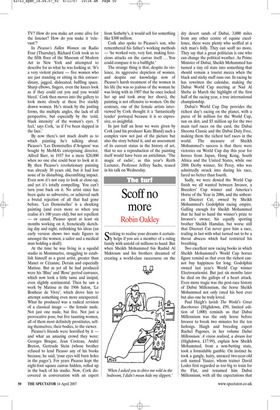Scoff no more
Robin Oakley
Seeking to realise your dreams it certainly helps if you are a member of a ruling family with untold oil millions to hand. But when Sheikh Mohammed bin Rashid Al Maktoum and his brothers dreamed of creating a world-class racecourse on the dry desert sands of Dubai, 3,000 miles from any other centre of equine excellence, there were plenty who scoffed at a rich man’s folly. They can scoff no more. They say that a great politician is one who can change the political weather. As Prime Minister of Dubai, Sheikh Mohammed has turned a tiny oil state into something that should remain a tourist mecca when the black and sticky stuff runs out. In racing he has rewritten the calendar, making the Dubai World Cup meeting at Nad Al Sheba in March the highlight of the first half of the racing year, a true international championship.
Dubai’s World Cup Day provides the richest day’s racing on the planet, with a purse of $6 million for the World Cup, run on dirt, and $5 million up for the two main turf races on the card, the Dubai Sheema Classic and the Dubai Duty Free, making them the richest turf races in the world. The measure of Sheikh Mohammed’s success is that there were victories on World Cup day this year for horses from Japan, Hong Kong, South Africa and the United States, while our 2006 Derby winner, Sir Percy, who was admittedly struck into during his race, fared no better than fourth.
Sadly, we were denied the World Cup finish we all wanted between Invasor, a Breeders’ Cup winner and America’s Horse of the Year in 2006, and the unbeaten Discreet Cat, owned by Sheikh Mohammed’s Godolphin racing empire. Galling enough for Sheikh Mohammed that he had to hand the winner’s prize to Invasor’s owner, his equally sporting brother Sheikh Hamdan, but worse still that Discreet Cat never gave him a race, trailing in last with what turned out to be a throat abscess which had restricted his breathing.
Two excellent new racing books in which Sheikh Mohammed’s World Cup horses figure remind us that even the richest cannot buy happiness for long. Godolphin owned last year’s World Cup winner Electrocutionist. But just six months later he died on the gallops of a heart attack. Even more tragic was the post-race history of Dubai Millennium, the horse Sheikh Mohammed not only rated his best ever but also one he truly loved.
Paul Haigh’s lavish The World’s Great Racehorses (Highdown, £99, limited edition of 1,000) reminds us that Dubai Millennium was the only horse before Invasor to break two minutes for the ten furlongs. Haigh and breeding expert Rachel Pagones, in her volume Dubai Millennium: A vision realised, a dream lost (Highdown, £17.99), explain how Sheikh Mohammed, from a non-betting state, took a formidable gamble. On instinct he took a gangly, hairy, unraced two-year-old colt named Yaazer, whom trainer David Loder first regarded as too big to train for the Flat, and renamed him Dubai Millennium, with all the expectations that was bound to arouse for the 2000 World Cup. Dubai Millennium, who won every race he ever ran in save the Derby, set off that year round Nad Al Sheba at a pace none of those watching believed could be sustained ... and won by a majestic six lengths. But that summer he broke a leg on the gallops. He was saved and began stud duties, only to develop grass sickness in his first year. Despite a massive team effort to save him, Sheikh Mohammed’s star had to be euthanised to save his suffering.
Rachel Pagones not only takes us through the racing career and the medical history of an extraordinary horse. She also reveals much more than racegoers ever see about the man behind that penetrating gaze, the disciplined, questing, innovative prime minister and bloodstock mogul.
Dubai Millennium was a swaggering brute to most who entered his box. But Sheikh Mohammed, who truly loves his horses, used to stand with him stroking his tongue, the horse sticking his head in the crook of his arm. Sometimes as night advanced he would sit for hours in the box with the horse who he was always convinced was something special, ‘the sort of horse you wait 20 years to find’.
For Paul Haigh, the best Dubai World Cup was the epic that saw François Doumen’s veteran Jim and Tonic prevail over Australasia’s Sunline and Hong Kong’s Fairy King Prawn. His volume is part travelogue, part racing history, part opportunity to thump his soapbox (quite right, Paul, why are European trainers, who think they are so good with jumpers, so reluctant to contest the Grand Jump at Nakayama for the richest prize in the steeplechasing world?). The nuggets you encounter with all the pleasure of putting on your racing suit and finding a forgotten winning Tote ticket in the pocket.
You could quibble with his inclusion of Hong Kong’s Happy Valley, since all the best Hong Kong horses go to Sha Tin. But like Paul Haigh I have paid my homage to Phar Lap’s stuffed carcase in the Melbourne Museum, and I was fascinated to learn that at Flemington in 1930 Australia’s greatest-ever won the equivalent of four Group Ones within a week, including the Race That Stops a Nation, the Melbourne Cup. No wonder he had a 14lb heart.
Good on yer too, Paul, for standing up for Epsom, disdained by some as ‘the world’s best race run on the world’s worst racecourse’. Phooey. As Paul says, the Epsom turns and ascents, the camber and the crowds require a horse with manoeuvrability, with the ability to quicken when required and a decent temperament. ‘Chicken-hearted horses, horses with physical defects, horses with personality disorders cannot win the Derby.’ Move it and it would not be the Derby. And Sir Percy will win again.



































































 Previous page
Previous page